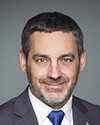If I may, I will answer in English,
because I'm going to get a little passionate about this.
I come from a site where we have been in the community for 40 years. Our museum actually is a community museum. We're also an old national exhibition centre, which was created in 1972.
Our community decided that even though the federal government abandoned the project in 1999, we would continue with it. We were very happy to putz along with our lovely little site, but we had a major problem with it in 2009. We had a mould problem that actually caused us to close for four years. We travelled around the community with the collection, sitting in various arenas and different sites, which caused me to go very grey and all those wonderful things, but we were able to reopen. The community itself really saw the importance of the museum. There was a lot of press. Locally and regionally, the community wanted this piece still to be there, so we came back.
To make a long story short, we're actually applying to the Cultural Spaces Fund, hopefully for that June 30 deadline, to look at expanding our site. The process has been very welcoming. It's been very...I'm not going to say “simple”, because it hasn't been, but it's been very easy to apply. I encourage other museums to take advantage of it at this point in time, because there is a willingness to work with museums.
We thank you for that. It's something that I think is really useful. The new criteria in terms of what is available for museums within the Cultural Spaces Fund is encouraging. I hope that continues.
It certainly won't solve everybody's problems, but it is a nice little safety valve for those of us who need things like HVAC controls that need to be rejigged. We're looking at additional space for the community and at working with other partners in the community to bring in that community. I think the Cultural Spaces Fund will be of benefit. There's a huge influx of money this year, and I hope that will continue onwards. I know there are lots of other pressures, but it will help museums, and I encourage everyone to use it.
Thank you.




